Yates Account
Join now
Create a Yates account today!
Sign up to join the Yates Garden Club for monthly e-mails packed with seasonal inspiration, tips for success & exclusive promotions.
Plus if you’re a Garden Club member you can take part in the Yates Growing Community - a blog to share successes, get advice & win prizes in fun challenges along the way!

Forgot password
Enter the email address associated with your account, and we'll email you a new password.

If you’re new to roses, you’ll encounter a bewildering number of different names and categories. This is our quick guide to the rose family - we’ll explain where each type fits in, give you the highlights for each of them, and their basic care requirements.
Here’s how to choose the best rose for your garden.
Roses can be categorized into three main botanical groups, that reflect how far they’ve evolved from their wild origins, plus indicate when they were first cultivated.
1. Species Roses
These are ancestral roses, in their original wild forms (including selections, but not hybrids).
2. Old Garden Roses
This group includes all the different types of roses that were bred by gardeners before 1867. The date is because 1867 saw the introduction of ‘La France’, the first hybrid tea rose, generally agreed to be the very first 'Modern' rose.
3. Modern Roses
By far the largest category, this group includes the myriad of rose cultivars developed after 1867.
The three main groups can be further subdivided into overlapping groups that describe important physical characteristics of each rose. By assigning a particular rose into all of these subgroups, you’ll be able to accurately predict its garden behaviour and care requirements.
The first subgroup categorises roses by their growth habit:
-
- Bush Roses are compact in size, usually between 0.8m and 1.2m high, with rigid, woody stems that need pruning each winter to force an abundant show of blooms.
- Shrub Roses grow larger, ranging from 0.5m to 6m in height, spreading up to 5m wide. They're extremely varied in habit, leaf shape and flower form. They don't need a lot of pruning.
- Climbing Roses will climb vertically when they have a structure or wall to support them, commonly reaching 3m or more in height.
The second subgroup splits roses by how often they flower:
-
- Repeat flowering (aka ‘remontant’) roses have a second flush of flowers.
- Once-flowering (these roses flower only once per season).
The third subgroup divides roses by flower structure:
-
- Large flowered (flowers form on single stems).
- Cluster flowered (flowers form in clusters).
Roses are diverse, so there are lots of exceptions where a rose could fit into multiple categories. And because rose-lovers are equally diverse, there are different methods to make sense of the rose family! This guideline is old-school, but serves as a useful shortcut so you know what to expect from a rose…so you can decide if there’s a place for it in your garden.
When you're shopping for roses, you'll probably notice odd-looking abbreviations alongside the rose names, like 'MEIviolin' or 'KORbin'. These are examples of 'International Names' which register and identify a rose cultivar Worldwide. Often the first few letters will indicate the original breeder.
1. Species Roses
'Species' roses are varieties grown in their ancestral, wild form. They're once-flowering, producing single, fine-petalled flowers (mainly in spring). Blooms are followed by a display of decorative berry-like hips in autumn. Species roses are particularly resistant to pests and diseases and don't need much pruning, apart from removing straggly growth.
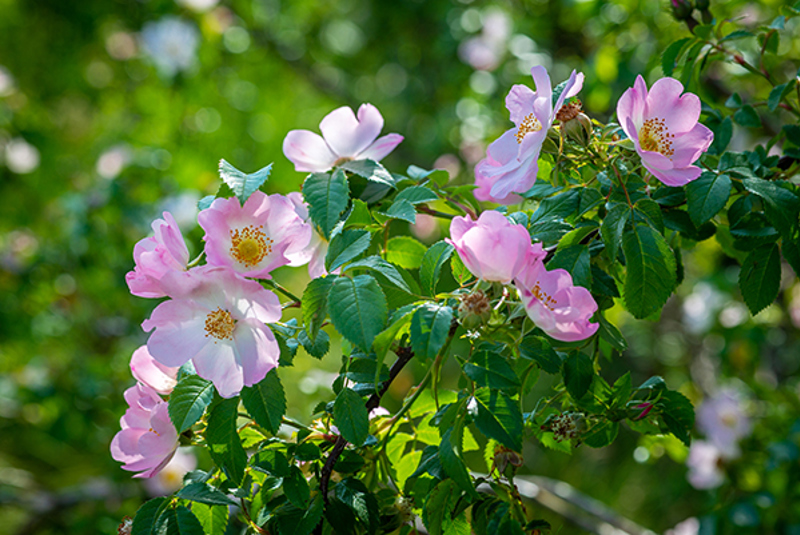
2. Old Garden Roses
'Old Garden' roses encompass a very broad group of rose species. Strictly speaking, to qualify in this category a variety needs to date from before 1867, but there are now lots of modern variants of the old cultivars. Lately, there has been an upsurge in interest in them due to their reliable garden qualities. Old garden roses have made a comeback with discerning gardeners, because they're particularly fragrant and hardy, and have a delightful, informal character.
The meaning of the term ‘Heritage Roses’ is roughly similar, but it's a different method of classification to the one we are using; it describes roses that were bred more than 75 years ago, so it includes a much bigger group of rose varieties than our 'Old Garden' category.
It's useful to divide Old Garden Roses by flowering habit - into a remontant group and a once-flowering group.
The repeat flowering group includes China Roses, Hybrid Chinas, Tea Roses, Bourbon Roses, Noisette, Portland and Hybrid Perpetual roses.
Once-flowering types include Gallica, Damask Roses, Albas, Centifolia, Moss Roses and Ayrshire roses.
It's best to prune Old Garden roses very lightly. Remove dead wood each year in winter, but when you shorten the stems back to a strong bud, make certain you don't cut them back by more than 1/4 at a time. When in doubt, you can get away with skipping the winter prune for a year and simply deadheading the spent flowers.
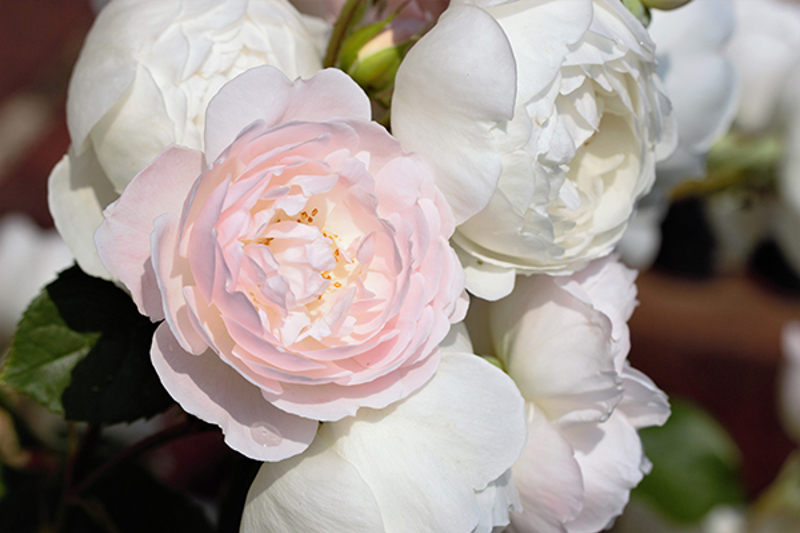
2(b). Modern Shrub Roses
This is an 'in-between' sort of category; so we've tacked it on to the Old Garden Roses section, although these are all technically Modern Roses. 'Shrub Rose' is often used as a general term to describe 'Old-Garden-lookalike' modern hybrids. These hybrids are crosses between old garden and species roses, floribundas and other modern types; they tend to have the tall, spreading growth habit of an Old Garden shrub rose, but they also have Modern benefits bred into them. This group is extremely varied in growth habit, size, leaf shape and flower form. Some of these roses can grow larger in NZ than in their country of origin, but your rose grower will know what to expect.
They don't need much pruning, other than getting rid of spindly or weak growth. The group includes:
- Rugosa Hybrid Roses - Famously disease-resistant, cold-hardy, unfussy about soil and rugged enough to tolerate coastal planting. Large, fragrant flowers. A popular choice for harvesting rosehips, for jam and preserves.
- David Austin Roses - Bred to combine the gorgeous scents and graceful shape of Old Garden roses with the fabulous colours and repeat flowering habit of modern hybrids. Vigorous growers, renowned for their large, fancy cupped blooms.
- Hybrid Musk Roses - Fabulously scented, wide and tall arching habit, generous clusters of floribunda-like flowers.
- Groundcover Roses - Low-growing plants that spread out over a wide area. Hardy, vigorous, abundant flowers. Ideal for massed planting or small gardens. Very little pruning is required.
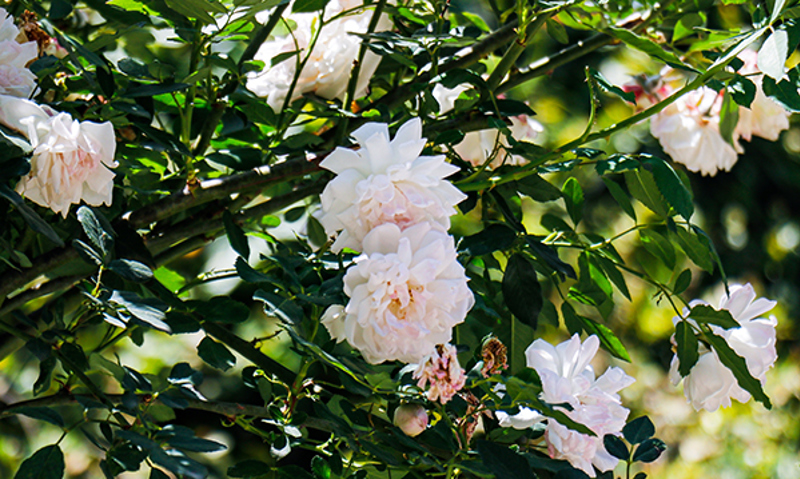
3. Modern Roses
This very broad group includes Hybrid Tea Roses, Floribundas, Grandifloras, Miniature Roses and Climbing Roses. We'll step through these in turn, as these are the roses you'll see most often in gardens.
Hybrid Tea Roses
The most widely grown form of rose, modern hybrid teas are the results of more than a century of breeding for delicate colour and fragrance. They produce large, well formed solo flowers in a wide range of colours on long, upright stems. They make a good garden display, but this type of rose is all about admiring the perfect individual blooms. These are the best roses for cutting: they're absolutely beautiful showcased in a vase. Scent is variable; a lot of hybrid teas have no fragrance but there are plenty of scented varieties available.
Hybrid Teas are always grafted onto strong rootstock and grow to about 1.5m in height.
Newly-planted hybrid teas are pruned to train them into an open 'cup' shape of woody stems. Each year during winter dormancy, bushes are pruned to remove dead wood. The live stems that are left will be 1-3 years old. Then, these live stems are shortened back to a strong bud - these buds will sprout new lateral stems, that deliver the spring blooms. Pro Tip: Make sure you never shorten stems by more than 1/3.
After you've cut the spring blooms to enjoy in a vase, new sub-lateral stems will develop below the cut, to produce a second flush of flowers. Repeat blooming roses like these are known as 'remontant' roses.
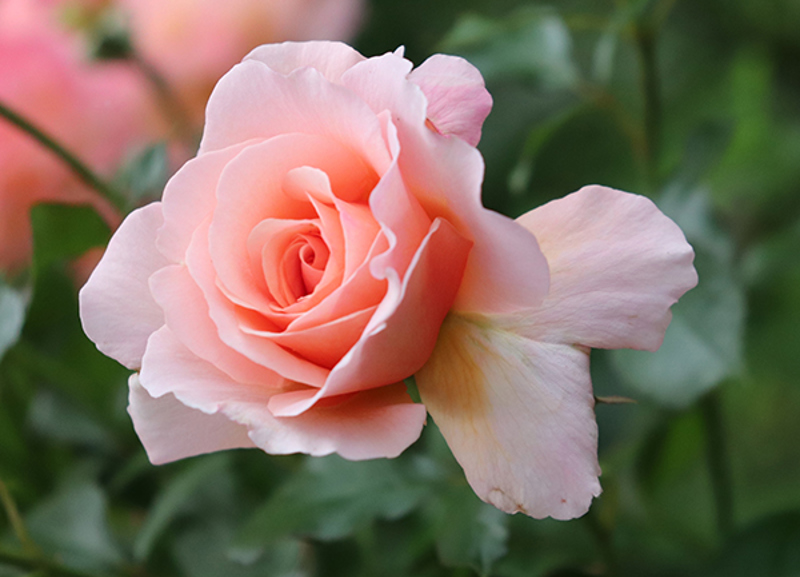
An 'Augusta Luise' hybrid tea rose.
Floribunda Roses
Floribunda roses bear abundant clusters of small blooms, in a wide variety of colours. The flowery trusses of floribundas aren't as practical for cut flowers as hybrid teas, but they provide a much more lavish display in the garden, over a longer period. A lot of floribundas have no scent, but highly fragrant varieties are available.
Usually grafted onto rootstock, they're generally hardier than hybrid teas and only reach about 90cm in height.
Like hybrid tea roses, floribundas bear flowers on one-year-old stems, so new growth is best pruned lightly. Don't be shy with the old woody growth though, prune it hard during winter. The remaining live stems are pruned back to a strong bud - these buds will sprout new lateral stems, that deliver the spring blooms.
Pro Tip: Make sure you never shorten stems by more than 1/3.
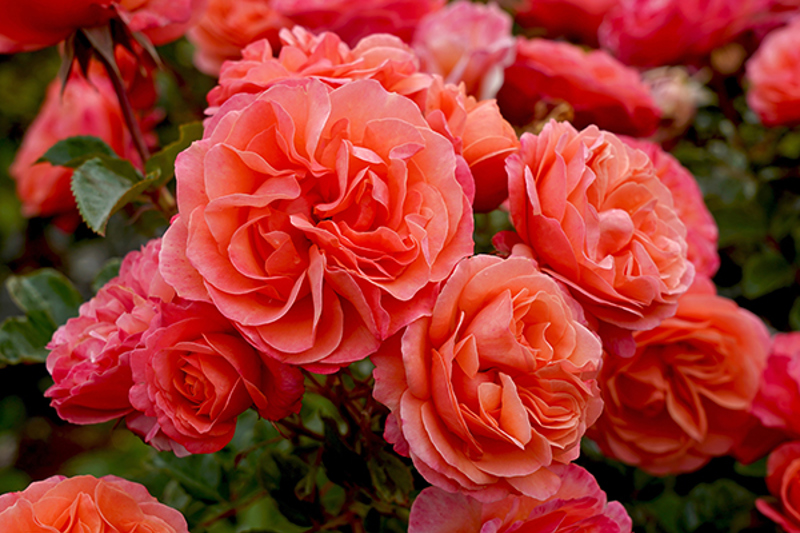
Floribunda 'Coral Lions-Rose'
Grandiflora Roses
A cross between hybrid tea roses and floribundas, that combines the most attractive qualities of both. You'll mostly see this type mentioned in websites or books from the USA, as European growers traditionally assign these 'intermediate' roses as either a hybrid tea or a floribunda.
The flowers look like slightly smaller hybrid tea blooms on tall stems...but the abundant clusters of flowers and continuous blooming are just like a floribunda. They grow quite tall (up to 1.8m) so they make a striking statement in a garden. Usually they aren't very fragrant, but the gorgeous floral display more than makes up for it.
For pruning, treat grandiflora roses just like hybrid tea varieties.
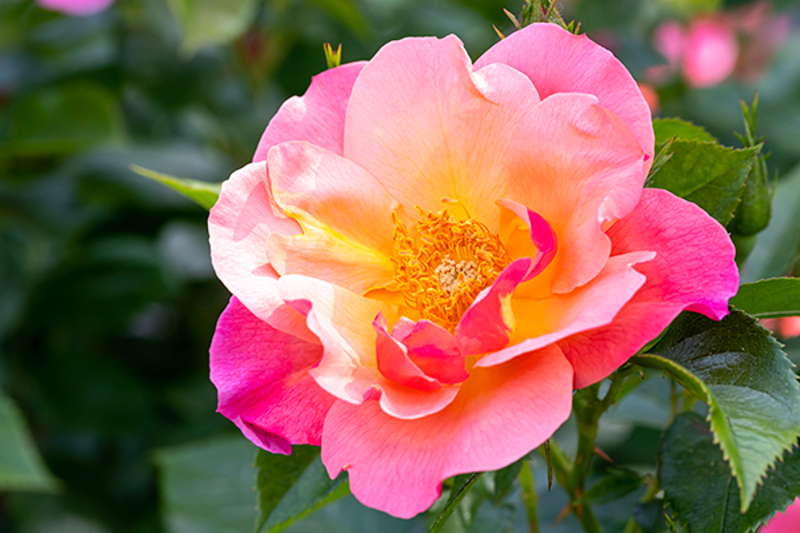
Grandiflora 'Centennial' rose
Polyantha Roses
An old-fashioned hybrid tea cross, polyanthas aren't widely grown but deserve to be, because of their hardiness! Their abundant small blooms can be single, semidouble or double in form and generally produce a more subtle display than floribunda types. A relatively low height makes them an excellent choice for mass planting.
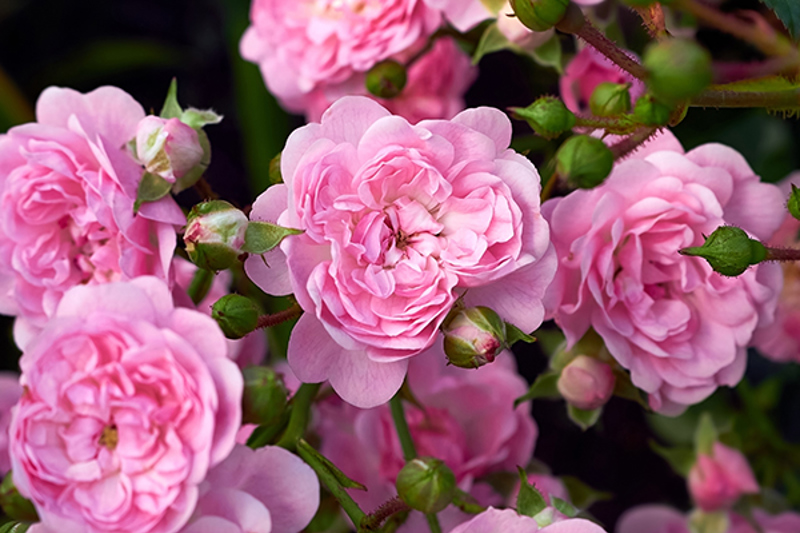
Polyantha 'The Fairy' rose
Miniature Roses
Miniature roses are tiny floribundas or hybrid teas, with little leaves and wee flowers in perfect proportion. They normally grow between 20–50cm high and are almost thornless. They can be used for edging, growing in containers, rockeries, window boxes or indoors as temporary houseplants. These little beauties aren't grafted.
They only need minimal pruning, to maintain a nice shape. Cut out deadwood, then shorten live stems back to a strong bud - these buds will sprout new lateral stems, that deliver the spring blooms. Pro Tip: Make sure you never shorten stems by more than 1/3. Remove spent flowers as needed.
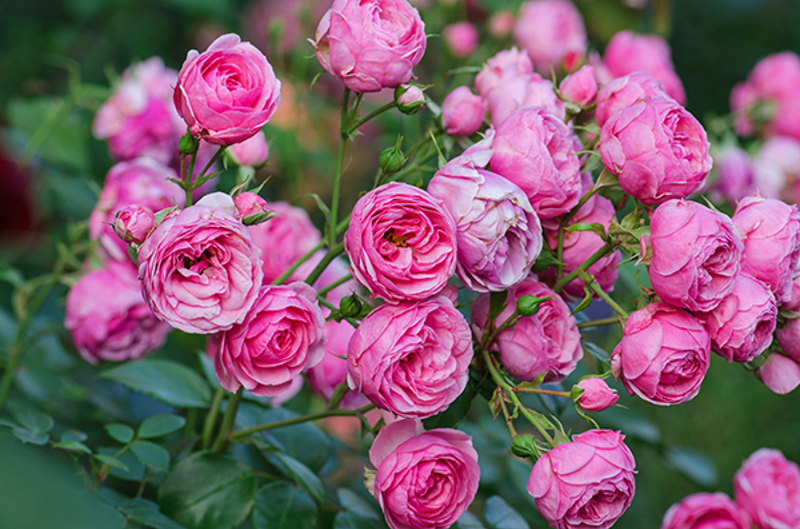
A miniature 'Pomponella' floribunda rose.
Climbing Roses
This is a large and diverse group, with a vast range of beautiful roses to choose from. Rambling Roses and Climbers are included in this group because they both climb when they have a structure or wall to support them. However, we'll consider them separately, because they're distinct rose types, that have very different care requirements.
(a) Rambling Roses
Ramblers are covered with a stunning display of petite flowers when they bloom in spring. They're vigorous growers, with long, pliable canes that bear large tumbling trusses of smallish flowers. They produce several of these strong, flexible stems from their base each year, which you can tie into place to scramble up a trellis, pergola or wall. Alternatively, they're well-suited to an informal garden where they can sprawl on neighbouring shrubs or trees; they can spread out to 4-6m.
The canes of ramblers only flower once. Each year, they need to be pruned right back to the ground straight after flowering, so new flowering stems can grow up again next season. Because ramblers need to be re-trained every year, if you prefer the formal look they demand a bit more work than most rose types, but you don't need to train them if you plant them amongst shrubs that can hold them up in a big flowery mass.
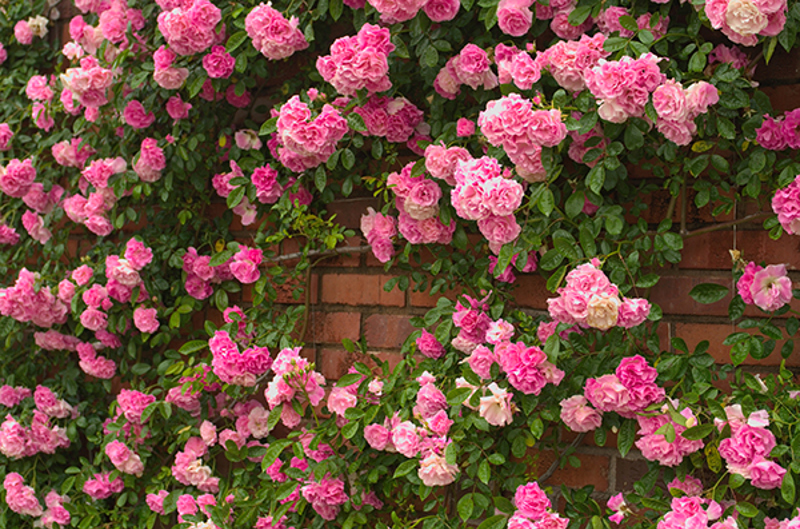
A rambling rose.
(b) Climbers
Climbers grow stout, rigid stems and their height potential is far greater than ramblers - growing up to 6m tall and spreading 3-4m. They generally need to be secured to the support structure they're leaning on. Although they're quite hardy, climbers are usually less vigorous than ramblers. Generally, climbers are repeat flowering, with larger flowers than ramblers. Climbers are deservedly popular for their fragrance; flowers range from gorgeous massed clusters to single, large blooms.
A common reason to choose climbing roses over ramblers is that most climbers will bloom twice a year. These 'remontant' climbers are pruned during winter dormancy, a little harder than most rose types. Thin out dead wood, then shorten the live lateral stems, only retaining 3 buds on each. Once established, climbers don't shoot many new canes from the base, so be cautious about cutting canes right back to the ground. Look for lateral stems emerging from higher up the canes to give you the growth you're after.
It's best to plan ahead and check the full-grown height of a climber, to make certain it won't grow too big for your space (otherwise you'll need to constantly prune to keep it under control).
Pro Tip: Once-flowering climbers don't respond well to severe pruning, so for those just take out the dead canes, no stem shortening is needed.
Did You Know?
The 'Winter Rose' or Hellebore isn't related to the rose family at all. In fact, they're members of Ranunculaceae, the buttercup family. Find out more about Hellebores here.

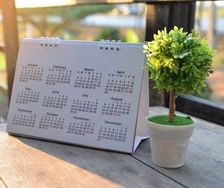












Share
Share this article on social media